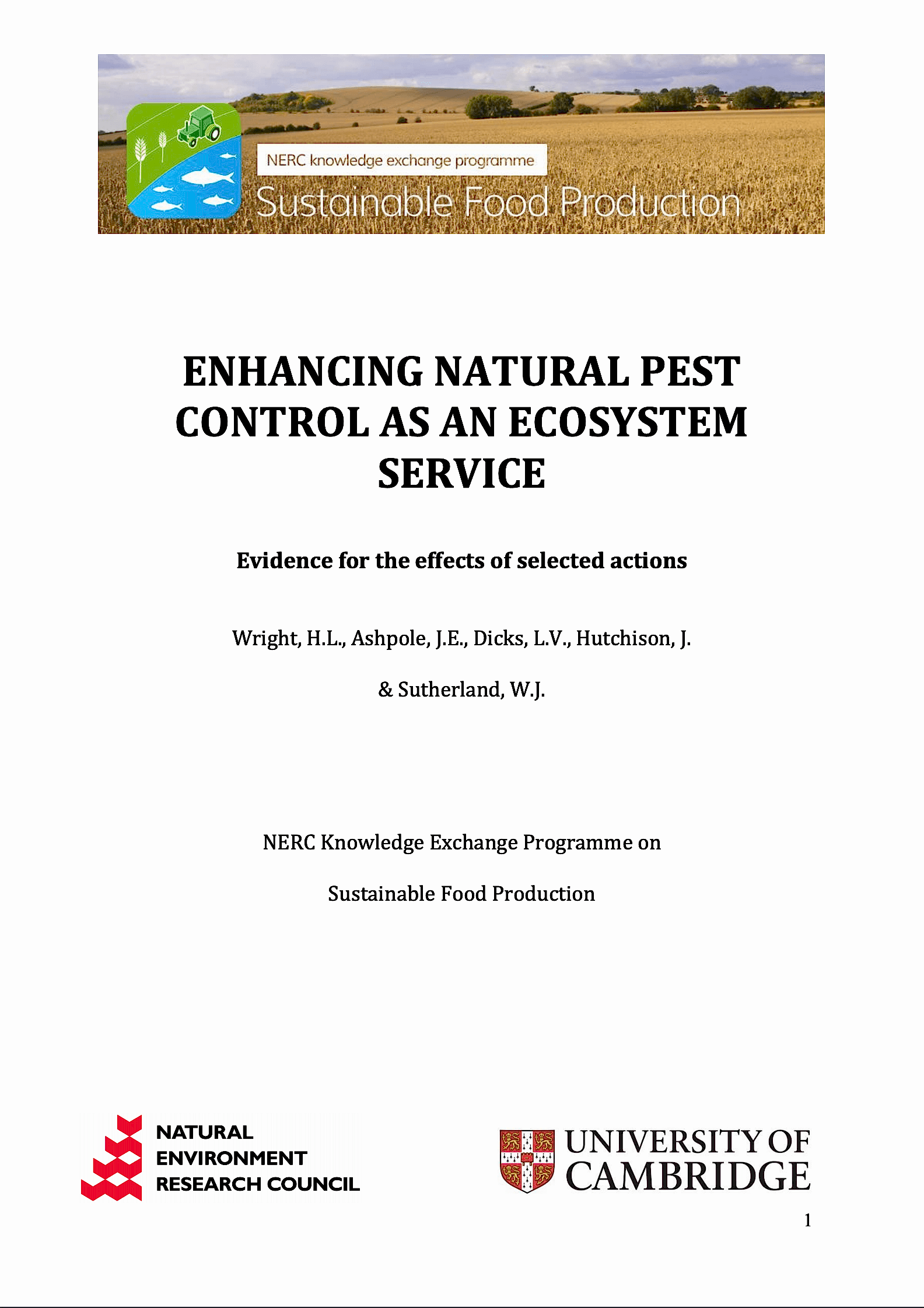Plant new hedges
Overall effectiveness category Unknown effectiveness (limited evidence)
Number of studies: 4
View assessment score
Hide assessment score
How is the evidence assessed?
Effectiveness
20%Certainty
19%Harms
20%
Study locations
Supporting evidence from individual studies
A trial in 1996 in Ouarville, France (Fournier & Loreau 1999) found higher numbers of a predatory ground beetle Pterostichus cupreus in a newly planted hedge (273 catches/trap) than 10 m and 110 m into the adjacent barley Hordeum vulgare crop (23 catches). Other ground beetle (Carabidae) species, including Pterostiehus melanarius, had similar numbers or were only slightly more numerous in the hedge than the crop. Ground beetle diversity in the crop declined with distance from the hedge. The hedge was planted in 1995 and comprised two 200 m sections of shrubs divided by a 100 m section of mixed fodder crops (oat Avena sativa and cabbage Brassica oleracea). It was separated from the adjacent barley crop by a 9 m-wide zone planted with oats and sorghum Sorghum bicolor. Ground beetles were sampled using pitfall traps in the hedge (15 traps) and at intervals between 10-110 m from the hedge in the adjacent crop (four traps at each of five distances). Traps were emptied every 2-4 weeks (April to mid-October 1996). Fenced pitfall traps (12 in the hedge and three 110 m into the crop) were used to estimate absolute densities and were emptied every day for eight days in June 1996.
Study and other actions testedA randomised, replicated, controlled trial in 1995-1996 in Machakos, Kenya (Girma et al. 2000) found the type of hedge species affected the abundance of some but not all natural enemies and pests in bean Phaseolus vulgaris or maize Zea mays plots. During the dry season, there were more wasps (Hymenoptera) near hedges of croton Croton megalocarpus, gliricidia Gliricidia sepium, mulberry Morus alba, siamea Senna siamea and spectabilis Senna spectabilis (averaging 19-25 wasps/trap) compared to other hedge species (10-15 wasps). Spiders (Araneae) were more abundant near hedges of calliandra Calliandra calothyrsus, croton, grevillea Grevillea robusta, lantana Lantana camara and siamea than other hedge species. Hedge type did not affect ladybird (Coccinellidae) or aphid (Aphidoidea) abundance or levels of pest infestation in beans and maize. Hedges were planted 8 m upslope of 10 x 10 m plots in 1993 using nine tree/shrub species (as above, plus flemingea Flemingia macrophylla) and pruned to 0.5 m. Beans were grown in the short- and maize in the long-rain season. There were four replicates/hedge species. Two yellow pan traps and two pitfall traps were placed in each plot (one of each near the hedge, one of each 4 m away) and monitored every 10 days.
Study and other actions testedA randomised, replicated, controlled study in 1998-1999 on a farm in western Kenya (Kandji et al. 2002) found two nematode (Nematoda) genera which parasitise plants were more numerous in plots with vs. plots without hedges of calliandra Calliandra calothyrsus and Napier grass Pennisetum purpureum (averaging 1,827-3,460 vs. 960-2,973 nematodes/l soil) during the cultivation period. Three nematode genera had similar numbers in plots with and without hedges (0-20 vs. 7-33 nematodes/l soil)during the cultivation period. Prior to cultivation, fallow plots with calliandra hedges had fewer individuals of five nematode genera and more individuals of two genera compared to fallows without hedges, but differences were small. There were four replicates of each treatment in 15 x 12 m plots. A year before sampling, hedges of one Napier grass and one calliandra row (50 cm apart) were planted on the upper and lower edges of the plots. Crotalaria Crotalaria grahamiana fallows were established in plots in June 1998 and cultivation began in May 1999, when the crotalaria fallow was cut and sown with maize Zea mays and beans Phaseolus sp.. Soil samples were taken every two months from September 1998 until September 1999.
Study and other actions testedA randomised, replicated, controlled study in 2005-2007 in Sichuan, China (Wu et al. 2009) found similar activity densities of ground-dwelling spiders (Araneae) in plots with hedges (averaging 123-212 captures/3 pitfall traps) and control plots without hedges (118-208 captures). Vetiver Vetiveria zizanioides hedges had higher spider densities than false indigo-bush Amorpha fruticosa hedges (57 vs. 44 captures/3 traps) and alfalfa hedges had higher densities than sabaigrass hedges (140 vs. 108 captures) in wheat fields in 2006-2007. Differences in spider densities between hedges and adjacent crops (within plots) varied between years, crops and hedge types. All hedges had higher spider densities than wheat Triticum sp. (averaging 26-52 vs. 16-20 captures/3 traps) in 2005-2006 but in 2006-2007 only sabaigrass Eulaliopsis binate and alfalfa Medicago sativa hedges had higher densities (34-46 captures) than adjacent wheat (16-17 captures). Sabaigrass and alfalfa hedges had higher spider densities (35-46 captures) than maize Zea mays (21-23 captures) in 2006 but hedges had similar densities to maize in 2007. Vetiver hedges, false indigo-bush hedges and bare control strips were tested in one field and sabaigrass hedges, alfalfa hedges and control strips were tested in another. Fields were divided into 7 x 6.5 m plots with each treatment replicated three times.
Study and other actions tested
Where has this evidence come from?
List of journals searched by synopsis
All the journals searched for all synopses
This Action forms part of the Action Synopsis:
Natural Pest Control
Natural Pest Control - Published 2013
Natural Pest Control Synopsis




















